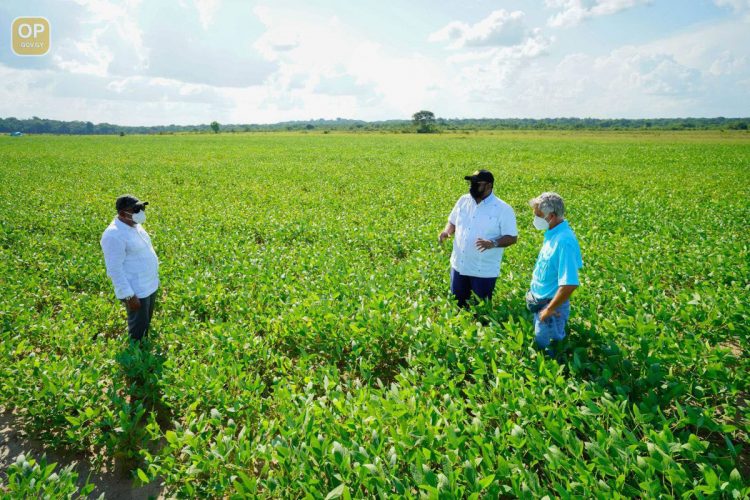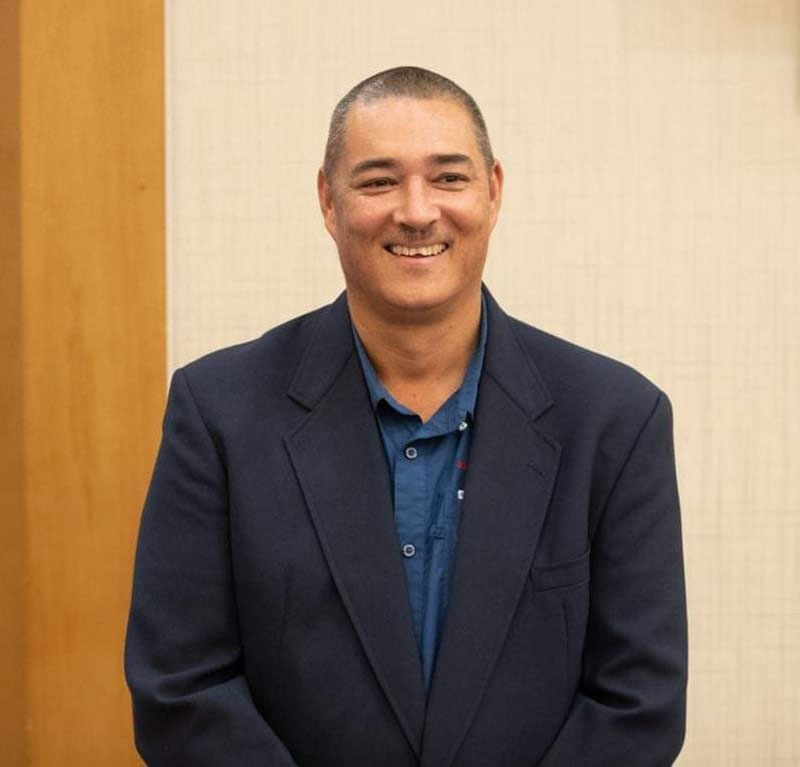-limestone to be imported for soil
A trial cultivation of soya beans in the Berbice intermediate savannahs has found it “very feasible” since two crops per year are possible as opposed to only one in northern Brazil and it is expected to result in a seven per cent reduction in the import of the crop for stock feed this year, local investor and businessman David Fernandes says.
It is because of the successful trial and government’s commitment to assist in the infrastructural development of the area that sees local investors now forging ahead with developing some 3,000 acres, having already ordered over 3,000 tonnes of limestone to mix with the earth, as they prepare the lands for large-scale farming.
“What we saw with the first trial – that first trial in 2021 – was that we could get two crops for the one year. We planted two successful crops and what that did was confirm to us that the region has enough rainfall that can give us what the Roraima region in Brazil and Rupununi cannot give us – two crops per year,” Fernandes of Bounty Farms told the Sunday Stabroek in an interview.

“So while we can’t get that in those regions, the Tacama/Ebini area has the ability to do it and we are excited. So, we have now embarked on developing the land the government has identified for us and we are moving to do two crops in 2022. It follows the same pattern so it will be reaped early 2023… and significant is that it will reduce our import by seven per cent. That, we believe, is big and critical,” he added.
The large-scale trial cultivation of corn and soya bean by private investors was announced in 2021 as they stated it was being explored as a means to safeguard the country’s livestock feed supply.
Spearheaded by a consortium of businesses in the livestock production industry that includes Guyana Stockfeeds Ltd, Royal Chicken, Edun Farms, SBM Wood, Dubulay Ranch, NF Agriculture, and Bounty Farm Ltd of which Fernandes is an executive, the trials began last year on 250 acres of lands owned by Alex Mendes of Dubulay Ranch.
“When we first planted, we used lands that are owned by Dubulay, by Mendes; it was Dubulay lands we did the trials on. We had an arrangement for the lands owned by Alex Mendes and he is still going to be a partner and he will use the lands we worked with him on and he will develop that to commercial quantities like us. The lands we are on now and that is being developed are lands that were identified for us”, Fernandes explained.
Pattern
He said that the lands were prepared and crops planted, as the team got much technical assistance and this revealed to them that the soybean plant can be produced very much in the same seasons as rice.
“It kinda follows the same pattern as rice. We follow the same rainfall patterns and it is probably the same period of time; around 110-118 days to grow the crop. We [Bounty Farms] will develop 1,000 acres and plant that twice a year, along with the others guys that are planting. So we will do about three thousand acres in 2022-2023 March,” Fernandes explained.
But because of the soil type and using the same process as with the trial lands, Fernandes said that they need limestone to add to the soil.
“The limestone is needed because our soil there is very acid and has a PH of between 4.1 and 4.7. I think (like) most of the lands in Guyana. For the soybean to be able to assimilate the nutrients in the soil, you have to be able to carry the soil’s PH from 4 to 6. When it goes there it can assimilate the fertilizer. In other words, the plant can’t see the fertilizer until it is neutralized. So simply put, if you put fertilizer in the soil and it is acid, the plant won’t be able to use or access it efficiently. So this is how limestone helps. It is amazing how much we learned during the Dubulay trials using the limestone. The limestone we are seeking from Dominican Republic is dolomitic, it means it has between 17 and 20 per cent of magnesium and that is very important. It is important because the soils in this region have a lot of aluminum in it. We mine bauxite in that region. But this ore is toxic to the plant. The magnesium will neutralise that and it will neutralise the aluminum toxicity,” he explained.
He added, “We have started fervently to start the marshalling yard and we are awaiting the limestone to come. We have built a dock at the Tacama Landing on the Berbice River where the limestone will come in a week’s time from Dom Rep [Dominican Republic]. We have started to do land clearing or land prep. We have to wait on the limestone because we want to incorporate that into the soil the same time we are preparing the land. It has been a little slow because this venture is new and we are bringing 3,200 tonnes of limestone up the Berbice River. There was no facility prior to be able to discharge this so we had a challenge.”
Explaining that the roadwork infrastructure cannot accommodate the weight of items needed currently, Fernandes said that the Berbice River is being used as the main medium of transport and that way has been working out “great”.
“We use the river. From the first trial, we knew that coming by road would not be as cost efficient as using the river. So the limestone, the grain will go by river. The fuel will come by road as the area’s roads are being developed. It is a bit more comfortable to drive in. To get to Linden is two hours so for critical stuff we will use the road. But large volume stuff will go by river,” he said.
“Having it so close to the Berbice River means we have a real great opportunity to be able to not only supply the Guyana market but keep heading north out of the mouth of Berbice,” he added.
And when the soya bean and corn are reaped, they will be dried at a facility that the government is setting up in proximity to the farms.
“At this point, we only will produce the beans and corn in that region, store it and dry it there at the facility that government is developing for us and we will put the processing facility at the mills which will have the extruders. At the extruders what it will do is separate the oil from the bean and help make the bean more digestible to the birds. The corn doesn’t need as much processing but the soya bean does,” Fernandes pointed out.
Government input
Government came in for high praise for its support of the project.
This year alone, government has budgeted some $887 million for infrastructure needed to support the large-scale cultivation.
Senior Minister in the Office of the President with Responsibility for Finance, Dr Ashni Singh, had told the National Assembly that government has committed $236 million for the procurement of a drying and storage facility and an additional $225 million installation and other works.
A further $426 million will be spent to complete the rehabilitation of 47 kilometers of a vital Ituni to Tacama farm-to-market road, starting from the junction of the Linden/Ituni road and heading east towards the Berbice River.
Last year, some $102 million was spent to commence rehabilitation works on the road.
“Without government’s support, I don’t think we would have been heading to this at this point. I think the offer given to us by government was such that it came at the right time. There was COVID and now Russia’s war against Ukraine, other global issues and cost of freight, and it shows that it is the right time to do it. We should have started this maybe two years prior but this is a good time and we thank government,” he said.
“They have committed to and are supporting us 100 per cent by doing what they said they will do. They are putting in infrastructure in terms of roads to get to the location, they have helped us with some implements, and they are also putting in a huge project where they are putting in a drying and storage facility at the Tacama Landing on the Berbice River, which is critical .They have invested and paid for the silos and drying facility. Right now the drainage and irrigation authority [NDIA] is doing work to put the silos down. I think those are critical things. All developing countries need help to boost their agri-industries and I think our government sees this,” he added.
The drying facility is integral because of the fragility of the crops, according to Fernandes. “When you bring the grain out to the field, if you don’t dry that right away it spoils, because it gets fungus. So if you bring grain out at 20 per cent [wetness] you have to get it down to 14 per cent [dryness] very quickly. It is just like rice. If you leave it in the bag when you bring it out, it will get hot, then fungus takes over resulting in discoloured grains and so on,” he related.
Upbeat about the prospects thus far, Fernandes revealed that by the end of the next crop, which ends sometime early next year, soya bean imports will be sliced by seven per cent.
“At the end of this year, we will be able to displace seven per cent of our imports, in that we will be able to reduce the soya bean import by seven per cent and this is very important. Once we get this commercial quantity those numbers will increase. We are working that 400 hectares or 2 km by 2 km. We will be able to ramp this up very rapidly and we believe we can be a part of the process in making that planned 25% by 25% [Caricom’s 25% overall food import reduction by year 2025] a reality because we have three years to do it.
He said that commitments are not one-sided as the investors are relying hard on making this country self-sufficient in its livestock feeds and the investors have vowed to repay the benevolence and support by doing all they can to ensure the project thrives. “We pay them back with blood, sweat and tears,” Fernandes assured.
Overall, the businessman said that he believes that as more people see the project’s feasibility and the development boom in the areas, they will begin setting up homes there.
He said that in giving them the lands for farming, government discussed their urban planning vision and it was why they can only work in certain areas.
“I think in time you will see there being very developed. The Vice-President had shared a vision when we were looking for places to work. They had already identified places we could not get because… of urban planning; where schools, hospitals, houses and overall development was mapped out. As this grows, and it will grow, we would see those. I know if we didn’t do this someone else would have and I am glad we did.
“I don’t believe we will be the only ones doing this. Our learning curve will help others to grow. We are taking the first jump and the risk and I am sure when others see the viability they will follow,” he added.





